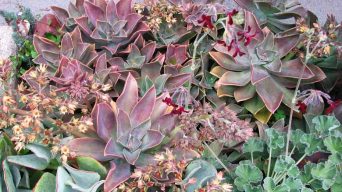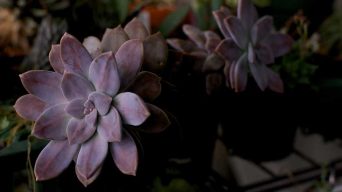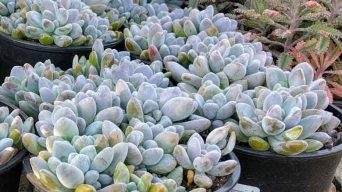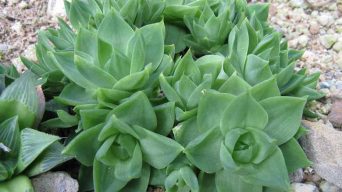Graptopetalum amethystinum, also called Lavender Pebbles or jewel-leaf plant, is a succulent plant that originates from the deserts of Mexico.
This succulent plant is a unique and interesting species that can be grown indoors or outdoors.
This article will provide you with all the information you need to know about caring for and propagating this beautiful, drought-resistant plant.
Overview
The Graptopetalum genus contains about 30 different species of flowering succulents from Mexico.
Some known species within the Graptopetalum genus include:
- Graptopetalum paraguayense
- Graptopetalum mendozae
- Graptosedum ‘Blue Giant’
- Graptopetalum rusbyi
- Graptopetalum bellum
Not only does this genus have a wide range of colors, but it also has different shapes, such as spherical or leafy rosettes.
The Graptopetalum Amethystinum succulent, commonly known as Lavender Pebbles or jewel-leaf plant, is part of the Crassulaceous family.
Lavender Pebbles grow in rosette-like clumps, usually from individual stems. The plant can grow up to 6 inches in diameter and 18 inches tall.
This plant’s leaves are plump and round with lovely lavender, pink, and green shades.
The star-shaped flowers of the Graptopetalum amethystinum succulent plant range in color from cream to light yellow at the base and red tips.
How To Care for Graptopetalum Amethystinum (Lavender Pebbles)
Graptopetalum amethystinum care is fairly simple, but there are a few things to keep in mind.
Below, you can find basic information to help you care for your Lavender Pebble plant.
Sun Exposure & Light Requirements
The Graptopetalum amethystinum is a succulent plant that can tolerate full sun to partial shade. Full sun exposure will give the best results in terms of growth and flowering.
However, the Graptopetalum amethystinum will also grow well in partial sun if given a place to hide from the scorching summer heat.
In this case, try planting your succulent plant on an east-facing window ledge so that it can soak up all of those sweet morning rays when they’re not too hot.
The Graptopetalum amethystinum will grow in the shade but won’t flower as much.
The succulent plant still needs a lot of light, and an east-facing window ledge is a perfect place for it to get that needling morning sunshine without scorching heat.
This way, your Graptopetalum can soak up some rays during those not-so-hot summer months, too!
If you don’t have any windows with eastern exposure or direct sunlight where you want to put your succulent plant, consider using artificial lighting.
Also, remember that most plants require more sun over time to maintain their healthy appearance and keep them blooming well.
Watering Requirements
Watering requirements for Graptopetalum Amethystinum are minimal, and it can be watered less than once per week. Only water when the soil is dry to about an inch down.
When watering, use just enough water to moisten all of the soil. Do not submerge the plant in standing water or leave sitting in wet soil.
It’s best to soak plants with ample amounts of potting mix rather than keeping them constantly soggy.
Graptopetalum amethystinum will lose its leaves if overwatered.
Make sure that you only give this cactus succulent enough water until there is barely any excess moisture on top of the surface -otherwise, it may rot and die.
Soil Requirements
Graptopetalum amethystinum is a succulent plant and therefore requires porous soil with good drainage.
The best type of potting mix for these plants would consist of two parts cactus potting mix, to one part coarse sand or perlite.
If using regular potting soil, organic material such as garden compost or peat moss can be added for improved drainage.
Black lava rocks also provide excellent drainage because they do not retain moisture.
Graptopetalum Amethystinum can grow with any type of succulent mix rich in nutrients and has enough water.
Cactus mixes work best because they are not very acidic.
Temperature and Humidity
The Graptopetalum amethystinum plant needs the same temperature and humidity levels as other succulents.
In most cases, this means a daytime high of 70 degrees Fahrenheit or 21 degrees Celsius with a nighttime low of 50 to 60 degrees F or 14 to 16 C.
There should not be much of variation in the temperature or humidity.
For example, when it is hot outside, you can place your Graptopetalum amethystinum plant in partial shade to help keep them cool.
It would be best to avoid direct sunlight as this may dry out the leaves and stems of your succulent plants.
If it’s too cold outside, try putting your Graptopetalum amethystinum near a window that gets good natural light but does not have harsh sun exposure.
This will give them enough energy and warmth so they don’t get snow burns on their branches or develop mold issues when winter comes around again.
The ideal humidity levels for Graptopetalum amethystinum are about 40% during the summer and 30-40% in winter.
You can maintain the humidity of your Graptopetalum amethystinum by misting it with a spray bottle three times a week or using a humidifier.
Fertilizing
Fertilize your plant every two to four weeks using either diluted liquid fertilizer (half strength) or slow-release granules, which should be applied around the base of each Graptopetalum.
- If using liquid fertilizer, use a half-strength solution and avoid getting it on any leaves or stems.
- For slow-release granules, make sure that you place them in an area where the Graptopetalum will not be disturbed for at least 12 months.
The best time to fertilize is in the early spring and late summer when growth rates are highest.
Do not feed your plant any other time during the year. If it stops growing or if its leaves get yellow from too much sunlight or windy conditions, you can feed it again. In this case, apply a diluted liquid fertilizer at full strength.
Potting and Repotting
Graptopetalum amethystinum plants are typically grown in containers.
When the container becomes too small for the plant, it is time to repot or pot up your Graptopetalum amethystinum into a larger one.
If the Graptopetalum amethystinum is not too large, you can carefully lift it out of its container and place it into a larger one using your hands.
If the Graptopetalum amethystinum is too large to lift, then carefully use a shovel or gardening fork and loosen the soil around the plant.
Carefully slip one hand into the container and grab hold of the original pot with your other hand.
Gently pull it out in sections until you have removed enough for you to be able to place it into another larger pot without doing any damage.
It will be time to fill that space using fresh cactus/succulent mix.
Once finished filling in all holes left after repotting, it is time to water the plant thoroughly and then repot into a container with fresh cactus/succulent mix.
You should always wait until after the rainy season to repot your plant, or else you will wind up with a rotten mess.
Pruning
Pruning plants is a necessary part of maintaining healthy and happy houseplants.
Graptopetalum amethystinum, also known as Lavender Pebbles, is no exception to this rule.
The best time for pruning these succulents is during their dormancy period in winter, typically from late November through March or April (though it will depend on your location).
Graptopetalums don’t require much more than an annual trimming when they’re grown indoors.
They grow quickly enough that you won’t need to do any severe cutting back unless you want to propagate new offsets.
To shape Graptopetalums into their natural form, trim back the tips of shoots to encourage branching.
Then, when you’re done pruning or propagating your Graptopetalums, ensure that they are well watered and placed in a sunny window.
Pests and Diseases
There are a few pests and diseases that Graptopetalum amethystinum can be susceptible to.
The most common is the mealybug, which will leave white cottony streaks or patches around the plant’s base.
To get rid of these bugs on your Graptopetalums, you should use an insecticide soap spray diluted at one tablespoon per quart of water in an irrigating can.
This solution needs to be applied weekly until all signs of infestation have cleared up.
It may take up to two weeks for any leftover eggs from adults who managed to survive this treatment cycle to hatch and die off themselves as well.
You also want to watch out for powder mildew since it can be a problem for Graptopetalums.
The best way to prevent this is by keeping the plant in areas with good air circulation, which will discourage fungal spores from settling on your plant’s leaves and stems.
You may also want to use an organic fungicide to help stop or slow down any powder mildew outbreaks before they happen.
How to Care for Graptopetalum Amethystinum (Lavender Pebbles) in Winter
Winter is the most important time of year for Lavender Pebbles care.
The best thing for Lavender Pebbles in the wintertime is warmth and bright light.
They should be moved indoors if possible, but if there isn’t enough room, move them as close as possible without risking frostbite.
This means avoiding drafts from windows and heaters, which can dry out their leaves. If moving them indoors, they should be placed by a window near natural light.
If the temperatures outside are too cold for them during this period, move them to an area protected from winter frost but still get plenty of sunlight and warmth.
It’s also essential to avoid exposing your plants to sudden temperature changes or draughts because these both cause leaf damage which may show up very quickly on these small-leafed plants.
You will need to check that the potting mix in your containers is moist and water it if necessary. But never let them sit too wet or for long periods because this can cause root rot.
How To Propagate Graptopetalum Amethystinum (Lavender Pebbles)
The easiest way to propagate this particular succulent is by taking leaf cuttings from healthy plants in your garden.
To take leaf cutting, select an area of the succulent that seems healthy with plenty of fleshy leaves on it.
Make sure to get at least two inches worth of leaves because this will produce roots after being watered (leave any small branches behind).
Remove all traces of soil between both ends before planting, each cutting halfway down deep enough so that just about one inch remains above ground level.
If there’s no soil available, use a potting mix or perlite.
Place the cuttings in an area with plenty of sunlight and water them at least once every week to keep the cutting nice and moist.
Once roots start growing (usually after about two months), you can transplant your new Graptopetalum amethystinum into any container with fresh potting mix and enough room for it to grow.
Is the Graptopetalum Amethystinum (Lavender Pebbles) Toxic?
Graptopetalum amethystinum (Lavender Pebbles) is not toxic to animals and humans.
As far as we know, Graptopetalums do not have any chemical compounds in them that would make them poisonous.
However, it’s always important to wear gloves and long sleeves when working in your garden, whether you’re planting something new or maintaining an existing garden bed.
Mainly when there’s any chance the plants may have come into contact with chemicals like fertilizers, herbicides, insecticides, etc., which can cause skin irritation & rashes.
Final Thoughts
Graptopetalum amethystinum is a relatively easy succulent plant to grow because it can thrive in many different environments.
This makes it a perfect plant for beginners or those who are just getting into the hobby of succulent plants.
With proper care, this plant will be able to spread its beauty around your home landscape for years to come.







